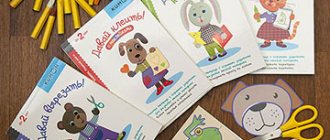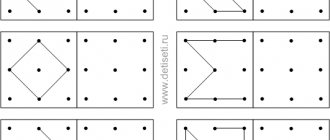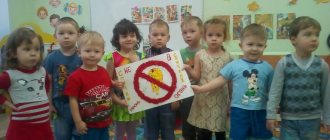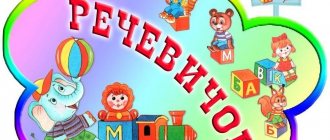SPEECH DEVELOPMENT in 1st junior group
SOFTWARE TASKS Enrichment of passive and active vocabulary
• Help expand children’s ideas about the world around them and express their knowledge and impressions in words:
- nouns: objects, their parts; objects and natural phenomena (trees, leaves, grass, flowers, snow, rain, wind, names of animals);
- generalizing words: toys, dishes, clothes, animals;
- verbs denoting actions with objects (put, place, etc.); actions characterizing the attitude towards people, including peers (sorry, give, help); labor actions of oneself and adults (cleaning, assembling, lifting, washing, etc.); actions expressing emotional state and relationships (rejoices, laughs, cries, regrets);
- verbs not only in the present, but in the past, future tense
- (I’m walking, I’m walking, I’ll go, I’m drawing, I’m drawing, I’ll be drawing);
- adjectives denoting qualitative characteristics of objects (small, round, soft, heavy, light) and natural phenomena (strong wind, black cloud, clear sky);
- pronouns (I, you, he, she, we, they, my, yours, me, you);
— adverbs denoting spatial and temporal relationships (above, below, next to, quickly, slowly).
Formation of grammatical structure of speech
• Agree nouns and pronouns with verbs and adjectives.
• Use prepositions in speech (in, on, for, under), conjunctions (because, so that).
• Use question words (Where? Where? Who? What? etc.) and various phrases.
Education of sound culture of speech
• Create conditions for the development of phonemic hearing, articulatory and vocal apparatus, speech breathing. Learn to pronounce isolated vowels and consonants (except for whistling, hissing and sonorant sounds), correctly reproduce onomatopoeia and words.
• Form intonation expressiveness of speech.
Development of coherent speech
• Improve understanding of adult speech: the ability to carry out his instructions; listen and perceive short stories without
• visual support.
• Develop the ability to enter into dialogue, address questions, requests, using polite words (“hello”, “goodbye”, “thank you”, “please”, etc.); stimulate proactive appeals in joint actions and games.
• Develop the ability to listen and retell fairy tales (together with an adult - persuade him). To promote the development of the ability, on one’s own initiative or at the suggestion of an adult, to talk about what is shown in the pictures, about toys, about events from personal experience (as a rule, mainly in the second half of the year).
To develop children's interest and positive attitude towards reading, listening, and dramatizing works of art together with adults
• a prerequisite for the development of the need to read fiction.
• Develop an understanding of the meaning of the situation described in a literary work, learn to express one’s attitude: in words (replicas, repetitions, questions), emotions and actions (carries a book, acts with toys, puppet theater characters).
Support and develop the child’s artistic preferences.
• Promote the development of children's imagination.
CONTENT AND ORGANIZATION OF THE EDUCATIONAL PROCESS
Speech development occurs in the process of meaningful communication with children in different types of activities. When implementing the content of different educational areas. Communication accompanies joint games, joint subject activities, etc. During this period, an adult is an attractive object of communication for the child, interesting in itself, especially close
adult. But even among close people, the child prefers those who communicate with him interestingly, in a businesslike manner, since the leading type of activity at this age is objective activity,
meeting the need for knowledge of the objective world and ways of acting with objects. The so-called “object fetishism,” as defined by psychologists, which dominates the child’s system of needs during this period, manifests itself in all types of activities: gaming, visual,
constructive, etc.
However, the process of learning and mastering this world is impossible without an adult. Therefore, for a child, an adult is a model of behavior, performing actions that are interesting for children. An adult is a bearer of a model, a norm, explaining and helping, collaborating with the child in the process of mastering the objects around him. An adult is a partner and at the same time a connoisseur, friendly, supportive, optimistic in assessing the process and the possibilities of the child achieving a result, coming to the rescue in cases of difficulties, believing in the child’s capabilities, excluding situations of hopelessness, bitter failures - range
interaction with the child in his zone of proximal development.
soon understands the importance and necessity of verbal methods of communication and masters them.
Thus, meaningful joint activity that requires coordination of interests, methods of action, and achieving a result that is interesting for the child is the basis for the child’s need for business communication, the satisfaction of which requires verbal methods of interaction in the child-adult community.
The most important condition for mastering verbal methods of communication is clear, clear, competent speech of people from the immediate environment. The native language, a natural speech space, neutral, perhaps, in relation to a particular child, not directly addressed to him in a given situation and therefore more complex in content, in vocabulary and grammatical support, is also necessary.
A child, from the context, spontaneously learns the meaning of individual words, ways of constructing sentences, and often appropriately reproduces them on his own initiative in a specific situation. Even more important are targeted natural dialogues with children in situations of joint games, construction, drawing, and cognitive observations.
A sample of an adult’s speech communication, simple in content, concise and accessible in terms of vocabulary and sentences, explanations, questions, comments, targeted activation in the speech of children of the dictionary, simple sentences, an exercise in their use that is invisible to the child
- an important component of meaningful interaction with children.
An exemplary speech space is unthinkable without the artistic word, which simultaneously affects the cognitive and emotional sphere of the child. Therefore, it is important to create conditions for the development of understanding and emotional attitude to the verbal artistic image. On this basis, it is necessary to promote the child’s independent, proactive approach to the artistic image: tell fairy tales and poems, look at books and illustrations, offer something to read, stage nursery rhymes, short poems, fragments of fairy tales.
Often children transfer an artistic image to different life situations that are close in content to the essence of this image. For example, a child climbed up a hill and shouts to the children: “I sit high, I look far away”; The kid draws on a piece of paper with a felt-tip pen and comments on his scribbles: “This is a cow, and this is a cow’s leg. And this doodle shark jumped up. Do you see? Now he’ll eat it!”).
Such an appeal to the artistic word, its transfer to new situations is the beginning of a creative attitude towards the artistic image. Saturating a child’s life with communication with books, the appropriate use of artistic images in a child’s life is the basis for the subsequent formation and development of a person’s not just literate, but imaginative, bright, beautiful, non-standard, convincing human speech. Therefore, it is necessary to continue to develop children’s interest in literature, using the literary word in various types of activities in which it is organic and natural.
can come in.
Recommended works of art (sample list)
Based on Russian folklore. “New mittens”, “Owl-owl”, “Come on, dear shepherdess”, “Oak-oaks”, “I’ll bake a pie for Tanya”, “Okay, okay, grandma baked pancakes”, “Gu-gu-gu -gu-gu-gu, in the green meadow”, “The cat went to the market”, “Rock-hen”, “Our ducks in the morning - quack-quack-quack”, “Like our cat”, “Zainka on the hay ", "Two birds were flying", "We lived with grandma", "Wolf-wolf", "You are geese, geese", "Little cowardly hare", "Gulya, gula-dove", "Like ours at the gate", " Like on thin ice”, “Rain, rain, more!”, “Rainbow-arc”.
Fairy tales. “The Ryaba Hen”, “Turnip”, “Kolobok” (arranged by K.D. Ushinsky), “Teremok”, “Masha and the Bear” (arranged by M. Bulatov).
Author's works. E.E. Moshkovskaya. “Doctor, doctor, what should we do?”; G.M. Novitskaya. “The river is flowing”; R.S. Sef. “The one who washes his hands with soap”, “Although I’m not big”; R.A. Kudasheva. "The Forest Raised a Christmas Tree"; M. Rodina. "Snowflakes".
Poems. A.L. Barto. “Toys” (“Bunny”, “Teddy Bear”, “Bull”, “Airplane”, etc.), fragments from the poems “Roaring Girl”, “Dirty Girl”, “April”; V. Biryukov. “The beetle has woken up”;
A. G. Kostetsky. "Barefoot Gosling"; E.E. Moshkovskaya. "Ears"; G.R. Lagzdyn. “Cockerel”, “Why is Egorka alone?”, “Bed”, “Washing”; E.A. Blaginina. “That’s what a mother is”, “We blow bubbles” (excerpt), “Rainbow”, “Our Masha”; E. Garlapak. "Snow Woman"; G.A. Ladonshchikov. "Winter"; Z.N. Alexandrova. “In little mittens”, “Felt boots”, “Delicious porridge”, “My bear”; N.P. Sakonskaya. “Where is my finger?”; I.P. Tokmakova. “Porridge”, “Garden”, “Autumn Leaves”, “Let’s Play”, “Bainki”, “Like on a hill - snow, snow”; N.V. Pikuleva. "Invitation to Dinner"; L. Gerasimova. “Legs are dancing”, “The Cherry Orchard”, “Gift for a Doll”, “Spring”; E.N. Uspensky. “About a boy who fights with a spatula”, “About a girl who sucks her thumb all the time”; G.A. Ladonshchikov. “Play Together”, “On the Sand”; L.M. Kvitko. “Swing” (excerpt); S.Ya. Marshak. "Ball"; L. Gerasimova. “Sunny Bunny”, “I draw polka dots”, “I draw the evening”, “We build a fortress from sand”;
B. D. Berestov. “Sick Doll”, “Sparrows”, “Happy Summer”; P.A. Samples “Treating a doll”; S.B. Kaputikyan. “Masha is drawing” (excerpt), “Masha is having lunch”; S.Ya. Marshak. "Children in a Cage", "The Tale of a Stupid Mouse"; L.N. Tolstoy. “Nastya had a doll”, “Three Bears”; K.I. Chukovsky. "Chick"; V.G. Suteev. “Chicken and Duckling”, “Under the Mushroom”, “Who Said Meow”; V.F. Korkin. “What grows in our garden bed?”; P.N. Voronko. "Pie"; M.A. Poznanskaya. "It is snowing"; O.I. Vysotskaya. "Snow Bunny"; B.V. Zakhoder. "Builders"; V.A. Levin. “Sparrow Bathing” (excerpt); A.N. Pleshcheev. "Autumn has come"; A. Brodsky. "Sunny Bunnies"; AND I. Yashin. "After the rain".
“Who is screaming?”
Target. Ensure that children correctly reproduce various onomatopoeias. Development of the ability to onomatopoeia, as well as speech hearing.
Preparatory work. Prepare toys: rooster, chicken, cat, dog, duck, cow. Think through questions for the text of the poem so that children actively use onomatopoeia in their answers.
Ku-ka-re-ku! I look after the chickens.
Where, whack, whack! She got carried away in the bushes.
Moore - purrr! I scare the chickens.
Am-am! Who's there?
Quack-quack-quack! It will rain tomorrow morning!
Moo-moo! Milk for anyone?
Methodical instructions. You need to read the poem expressively, and while reading, show the children the appropriate toys.






